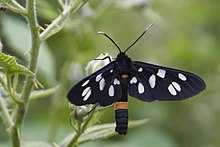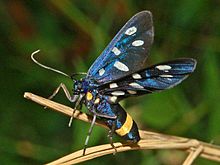411:
56:
74:
477:
42:
425:
of 35–40 millimetres (1.4–1.6 in). Males are smaller than females and have thicker antennae. Wings are blueish black or greenish black with white spots and metallic sheen. The number and the size of spots are quite variable. Usually there are six white spots on the forewings and two or three
547:, Band 4: Arthropoda - 2. Hälfte: Insecta - Lepidoptera, moths and butterflies, in Kristensen, N. P., Handbuch der Zoologie, Fischer, M. (Scientific Editor), Teilband/Part 35: Vol. 1: Evolution, systematics, and biogeography, Berlin, New York, Walter de Gruyter, 1999, pp. x + 491,
402:. It does not breed in the United Kingdom, but it is a very rare immigrant. It is also found In india these days. The species prefers drier areas, open ranges with shrubs and trees as well as open forests and warm, sunny slopes.
518:
and other low plants). The caterpillar hibernates in a silken nest and pupates in May in cocoons on the ground. Adults of this diurnal moth fly on warm sunny days from late May to August, depending on location.
426:
spots on the hindwings. The body is quite long, with a yellow spot on the second segment of the abdomen. A further feature is the prominent yellow ring at the sixth segment of the abdomen. The black thread-like
430:
have white tips. The caterpillars can reach a length of about 5 centimetres (2.0 in). They are gray black with thick dark brown, fluffy hairs that grow from small growths. The head is reddish brown.
209:
932:
981:
765:
614:
906:
589:
574:
552:
537:
1055:
488:). Females lay eggs on a variety of herbs. The larvae hatch in early August and are polyphagous, feeding on a range of herbaceous plants (
945:
867:
1040:
655:
376:
968:
722:
854:
885:
986:
390:
The nine-spotted moth is chiefly found in southern Europe but also seen up to northern
Germany, and in the east to
898:
1045:
760:
73:
1050:
797:
859:
1035:
950:
399:
188:
461:
774:
368:
218:
68:
937:
835:
410:
55:
1007:
585:
570:
548:
533:
445:
427:
960:
569:, 2nd ed., London, Oxford University Press & Natural History Museum, 2011 , pp. xi, 404,
1012:
736:
994:
769:
398:, and there are some populations in the south-eastern Dutch nature reserves of Leudal and
893:
880:
436:
753:
476:
1029:
372:
205:
784:
165:
973:
919:
829:
465:
125:
820:
693:
485:
457:
135:
872:
675:
514:
508:
460:
and is unpalatable to birds. The nine-spotted moth imitates its appearance (
155:
105:
85:
17:
642:
41:
846:
814:
490:
422:
395:
391:
364:
145:
999:
911:
924:
502:
115:
95:
791:
496:
475:
409:
360:
795:
584:, Dubuque, Iowa, Kendall/Hunt Pub. Co., 1991, pp. ix, 754,
560:
Guide des papillons nocturnes d'Europe et d'Afrique du Nord
735:
Mazzei, Paolo; Morel, Daniel & Panfili, Raniero
804:
738:Moths and Butterflies of Europe and North Africa
567:The Lepidoptera: Form, Function and Diversity
532:, Paris, Delachaux et Niestlé, 2007, 288 p. (
8:
792:
484:This species has one generation per year (
54:
40:
31:
602:
530:Guide des papillons nocturnes de France
231:
776:Butterflies & Moths of Switzerland
562:, Delachaux et Niestlé, Lausanne 1978.
623:Lepidoptera and Some Other Life Forms
528:Collectif d'entomologistes amateurs,
7:
899:104d0e82-96f9-43dd-9399-3ae910a2368d
755:Larvae of North-European Lepidoptera
687:
685:
671:
669:
667:
665:
608:
606:
25:
694:"72.0343 BF2070 The Nine-spotted
367:("tiger moths"). The species was
613:Savela, Markku (April 3, 2019).
464:). Both moths are an example of
72:
592:, LCCN 85081922, OCLC 13784377.
577:, LCCN 92004297, OCLC 25282932.
434:Similar-looking moths include
1:
1056:Taxa named by Carl Linnaeus
290:Syntomis phegea bessarabica
1072:
330:Syntomis phegea orientalis
721:Dawkins, Richard (1982).
558:P.C. Rougeot, P. Viette,
224:
217:
194:
187:
69:Scientific classification
67:
62:
53:
48:
39:
34:
386:Distribution and habitat
298:Amata phegea bessarabica
1041:Moths described in 1758
762:Lepidoptera of Belgium
724:The Extended Phenotype
481:
415:
545:Handbuch der Zoologie
543:Kükenthal, W. (Ed.),
540:), p. 97, n. 849
479:
413:
63:Female, ventral view
894:Fauna Europaea (new)
580:Stehr, F. W. (Ed.),
349:yellow belted burnet
768:2019-07-22 at the
482:
416:
35:Nine-spotted moth
1023:
1022:
1008:Open Tree of Life
798:Taxon identifiers
698:(Linnaeus, 1758)"
619:(Linnaeus, 1758)"
590:978-0-8403-3702-3
575:978-0-19-854952-9
555:, OCLC 174380917.
553:978-3-11-015704-8
538:978-2-603-01429-5
462:Müllerian mimicry
456:is in the family
451:
446:Zygaena ephialtes
442:
345:nine-spotted moth
341:
340:
334:
326:
306:
294:
286:
278:
270:
262:
254:
246:
238:
16:(Redirected from
1063:
1016:
1015:
1003:
1002:
990:
989:
977:
976:
974:NHMSYS0000501207
964:
963:
954:
953:
941:
940:
928:
927:
915:
914:
902:
901:
889:
888:
876:
875:
863:
862:
850:
849:
840:
839:
838:
825:
824:
823:
793:
781:
741:
733:
727:
719:
713:
712:
710:
708:
689:
680:
673:
660:
653:
647:
640:
634:
633:
631:
629:
610:
582:Immature Insects
450:(Linnaeus, 1758)
449:
440:
377:10th edition of
332:
324:
304:
292:
284:
276:
268:
266:Sphinx iphimedia
260:
252:
245:(Linnaeus, 1758)
244:
236:
200:
77:
76:
58:
44:
32:
21:
1071:
1070:
1066:
1065:
1064:
1062:
1061:
1060:
1046:Moths of Europe
1026:
1025:
1024:
1019:
1011:
1006:
998:
995:Observation.org
993:
985:
980:
972:
967:
959:
957:
949:
944:
936:
931:
923:
918:
910:
905:
897:
892:
884:
879:
871:
866:
858:
853:
845:
843:
834:
833:
828:
819:
818:
813:
800:
779:
770:Wayback Machine
750:
745:
744:
734:
730:
720:
716:
706:
704:
691:
690:
683:
677:Natura Bohemica
674:
663:
654:
650:
641:
637:
627:
625:
612:
611:
604:
599:
565:Scoble, M. J.,
525:
474:
408:
388:
379:Systema Naturae
369:first described
357:Syntomis phegea
337:
325:Obraztsov, 1966
305:Obraztsov, 1936
261:Fabricius, 1793
258:Zygaena quercus
242:Syntomis phegea
230:
229:
213:
202:
196:
183:
71:
28:
27:Species of moth
23:
22:
15:
12:
11:
5:
1069:
1067:
1059:
1058:
1053:
1048:
1043:
1038:
1028:
1027:
1021:
1020:
1018:
1017:
1004:
991:
978:
965:
955:
942:
929:
916:
903:
890:
881:Fauna Europaea
877:
864:
851:
841:
826:
810:
808:
802:
801:
796:
790:
789:
786:Lepiforum e.V.
782:
772:
758:
749:
748:External links
746:
743:
742:
728:
714:
681:
661:
657:Fauna Europaea
648:
635:
601:
600:
598:
595:
594:
593:
578:
563:
556:
541:
524:
521:
473:
470:
441:(Turati, 1917)
437:Amata ragazzii
407:
404:
387:
384:
363:in the family
339:
338:
336:
335:
327:
307:
295:
287:
279:
271:
263:
255:
247:
239:
237:Linnaeus, 1758
227:
226:
225:
222:
221:
215:
214:
203:
192:
191:
185:
184:
180:A. phegea
177:
175:
171:
170:
163:
159:
158:
153:
149:
148:
143:
139:
138:
133:
129:
128:
123:
119:
118:
113:
109:
108:
103:
99:
98:
93:
89:
88:
83:
79:
78:
65:
64:
60:
59:
51:
50:
46:
45:
37:
36:
26:
24:
14:
13:
10:
9:
6:
4:
3:
2:
1068:
1057:
1054:
1052:
1051:Moths of Asia
1049:
1047:
1044:
1042:
1039:
1037:
1034:
1033:
1031:
1014:
1009:
1005:
1001:
996:
992:
988:
983:
979:
975:
970:
966:
962:
956:
952:
947:
943:
939:
934:
930:
926:
921:
917:
913:
908:
904:
900:
895:
891:
887:
882:
878:
874:
869:
865:
861:
856:
852:
848:
842:
837:
831:
827:
822:
816:
812:
811:
809:
807:
803:
799:
794:
788:
787:
783:
778:
777:
773:
771:
767:
764:
763:
759:
757:
756:
752:
751:
747:
740:
739:
732:
729:
726:
725:
718:
715:
703:
699:
697:
692:Kimber, Ian.
688:
686:
682:
679:
678:
672:
670:
668:
666:
662:
659:
658:
652:
649:
646:
645:
639:
636:
624:
620:
618:
609:
607:
603:
596:
591:
587:
583:
579:
576:
572:
568:
564:
561:
557:
554:
550:
546:
542:
539:
535:
531:
527:
526:
522:
520:
517:
516:
511:
510:
505:
504:
499:
498:
493:
492:
487:
478:
471:
469:
467:
463:
459:
455:
448:
447:
439:
438:
432:
429:
424:
420:
412:
405:
403:
401:
397:
393:
385:
383:
381:
380:
374:
373:Carl Linnaeus
370:
366:
362:
358:
354:
350:
346:
331:
328:
323:
319:
318:phegea phegea
315:
311:
308:
303:
299:
296:
293:Stauder, 1924
291:
288:
283:
282:Spinx cloelia
280:
275:
274:Spinx cloelia
272:
267:
264:
259:
256:
253:Allioni, 1766
251:
250:Sphinx ligata
248:
243:
240:
235:
234:Sphinx phegea
232:
223:
220:
216:
211:
207:
201:
199:
193:
190:
189:Binomial name
186:
182:
181:
176:
173:
172:
169:
168:
164:
161:
160:
157:
154:
151:
150:
147:
144:
141:
140:
137:
134:
132:Superfamily:
131:
130:
127:
124:
121:
120:
117:
114:
111:
110:
107:
104:
101:
100:
97:
94:
91:
90:
87:
84:
81:
80:
75:
70:
66:
61:
57:
52:
47:
43:
38:
33:
30:
19:
1036:Amata (moth)
836:Amata phegea
806:Amata phegea
805:
785:
775:
761:
754:
737:
731:
723:
717:
705:. Retrieved
701:
696:Amata phegea
695:
676:
656:
651:
643:
638:
626:. Retrieved
622:
617:Amata phegea
616:
581:
566:
559:
544:
529:
523:Bibliography
513:
507:
501:
495:
489:
483:
454:Z. ephialtes
453:
444:
435:
433:
419:Amata phegea
418:
417:
389:
378:
375:in his 1758
356:
353:Amata phegea
352:
348:
344:
342:
333:Daniel, 1950
329:
321:
317:
313:
309:
301:
297:
289:
281:
273:
265:
257:
249:
241:
233:
198:Amata phegea
197:
195:
179:
178:
166:
29:
18:Amata phegea
920:iNaturalist
830:Wikispecies
780:(in German)
707:October 30,
628:October 30,
480:Caterpillar
466:aposematism
414:Mating pair
406:Description
355:, formerly
277:Esper, 1783
152:Subfamily:
126:Lepidoptera
1030:Categories
597:References
486:univoltine
458:Zygaenidae
421:reaches a
136:Noctuoidea
106:Arthropoda
515:Taraxacum
509:Gramineae
322:ukrainica
174:Species:
156:Arctiinae
92:Kingdom:
86:Eukaryota
946:LepIndex
938:10319573
844:BioLib:
821:Q1755105
815:Wikidata
766:Archived
491:Plantago
428:antennae
423:wingspan
396:Caucasus
394:and the
392:Anatolia
365:Erebidae
314:Syntomis
302:kijevana
219:Synonyms
206:Linnaeus
146:Erebidae
142:Family:
102:Phylum:
96:Animalia
82:Domain:
912:1808450
702:UKMoths
472:Biology
400:Meinweg
359:) is a
285:Esper,
269:Esper,
162:Genus:
122:Order:
116:Insecta
112:Class:
1013:653492
987:938170
886:446950
873:309241
860:258065
644:BioLib
588:
573:
551:
536:
503:Galium
958:LoB:
951:34275
933:IRMNG
925:57489
868:EUNIS
847:54841
497:Rumex
320:nat.
310:Amata
300:nat.
167:Amata
49:Male
1000:1758
982:NCBI
961:5385
907:GBIF
855:BOLD
709:2019
630:2019
586:ISBN
571:ISBN
549:ISBN
534:ISBN
443:and
361:moth
343:The
228:List
210:1758
969:NBN
371:by
347:or
1032::
1010::
997::
984::
971::
948::
935::
922::
909::
896::
883::
870::
857::
832::
817::
700:.
684:^
664:^
621:.
605:^
512:,
506:,
500:,
494:,
468:.
452:.
382:.
316:)
208:,
711:.
632:.
615:"
351:(
312:(
212:)
204:(
20:)
Text is available under the Creative Commons Attribution-ShareAlike License. Additional terms may apply.


